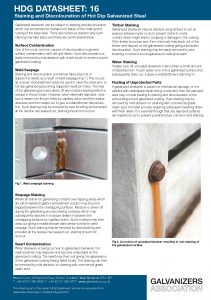About Hot Dip Galvanizing Defects
Galvanized steelwork can be subject to staining and discolouration which can sometimes be mistaken for failure of the coating and rusting of the base steel.
 There are numerous reasons why such staining may take place.
There are numerous reasons why such staining may take place.
Read the datasheet for more information on post hot dip galvanizing defects:
- Surface contamination
- Weld seepage
- Seepage staining
- Swarf contamination
- Timber staining
- Water staining
- Rusting of unprotected parts
Want to have a pdf version of this datasheet? Click the button below.
Surface Contamination
One of the most common causes of discolouration is general surface contamination with dirt and debris. Such discolouration is easily removed by mild abrasion with a wire brush to reveal a sound galvanized coating.
Weld Seepage
Staining and discolouration sometimes takes place at or adjacent to welds as a result of weld seepage (Fig 1.) This occurs as a result of pretreatment solutions used to clean the steel prior to hot dip galvanizing becoming trapped in weld pin holes.
Timber Staining
Galvanized steelwork may be stacked using timbers to act as spacers between work so as to prevent metal-to-metal contact which might lead to scraping or damage to the coating.
Rusting of Unprotected Parts
If galvanized steelwork is subject to mechanical damage, or it is welded with inadequate repair being conducted, then the exposed area may corrode leading to staining and discolouration of the surrounding sound galvanized coating.
Download the datasheet to find out how to remove staining and discolouration of the galvanized coating.

